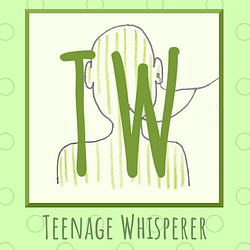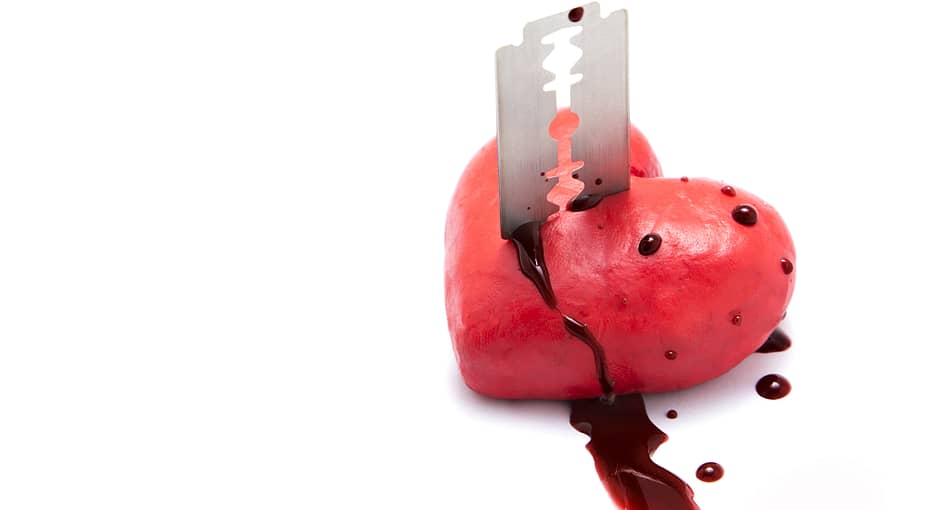If I could tell you first, I would. If I could string words and feelings together, I really would. If there was some comprehension, some stream of tangible consciousness the words would be there and all you would have to do would be to get me to speak them. But I do not have the words. I do not have the words to express that which screams and writhes within me.
Razors, glass, lighters and matches are my lips; the trickle of blood, the burn, the pain are my physical words. For others the smashing of bodies against walls, the ingestion of items like light bulbs, the pulling of hair are involved. Whatever the method, the physical words are still the same. The physical words that tell of our inner pain and our torment. The physical words that make sense of the inexplicable, the inexpressible. The self harm that momentarily allows us to emotionally speak and heal, to calm the roaring storm. That is until the ocean of pain, of raw distress stirs up again and the transient healing is undone and to our tools we return.
For in the physical expression of my pain I find control. My feelings try to have
mastery over me, try to consume me, but when metal or plastic connects with my flesh, I am not defeated. I take control of my emotions by distracting myself from my emotional pain with the experience of physical pain. The physical pain I am in control of, the emotional I am not.
A full exploration of my emotional pain, and the necessary full experience of that pain is something I cannot bear. I do not know what it really looks like, I don’t know if I have the strength to face this scary unknown, so I’ll opt for the predictability and the controllability of physical pain instead, a pain I am in control of. So I experience some power, even when the feelings of powerlessness of my present or memories of my past threaten to overtake me. But because I never address the real source of my pain it never lessens and I keep having to cut, to burn, to divert myself from it.
Sometimes an enormous sense of calm envelops me, the delicious dessert after the main course of tension, as blood drips, as skin burns, as the pain is released. My body relaxes, the turmoil subsides as the endorphins rush to respond to my physical pain, and calm me.
Sometimes it’s about punishment. Punishment for how I feel, about the vileness of me, what I have done, what has been done to me. And to inflict the punishment relieves the guilt and the shame and again, puts me in control.

Sometimes it’s about reconnection. Connecting with the body of me. I can become so removed, the fly on the wall of my own existence, that I need to check that I’m really still here, that I’m still human, that I’m still capable of feeling something. Life and experiences have taught me to disconnect. That when things get too violent, too violative, too near to the complete crushing of my soul that I should eject from myself, take myself somewhere else mentally. I am preserving my soul.
So I numb myself, numb myself from my experiences and the upshot is that I end up numbing myself from everything. I can become an emotional void, walking though life like an automaton. And I need to know I am still really here, that I am human, that I am capable of feeling at least physically. So I feel the burn on my flesh, the slam of my body against the wall and I momentarily reconnect with my body and feel something.
For many, tears do not come. We are so removed from ourselves, so desperate to avoid the depths and strength of our emotional pain that we do not allow it to register through our eyes, and definitely not in front of you. I do not want to show you my weakness, my vulnerability, to experience the humiliation. Just like we generally don’t parade our scars, our harming secrets and hide them under long-sleeved tops and long trousers, even in the height of Summer, we will not parade our pain in tears either.
So often the way we deal with our pain terrifies those around us- family, friends, professionals. Our actions are so alien, as much beyond their comprehension as my feelings are to me. Some see us as attention seekers but we are not. We largely operate in private and go to great lengths to hide our coping mechanisms. Others believe that they just need to get tough with us, be firm and tell us to stop. But this is futile. If we could stop do you not think we would choose to? We feel shame at what we do already without your judgement. Further judgement is only more likely to drive us to harm.
So what can you as our workers, our professional helpers, do for us?
How can you help us?
1. Don’t judge, instead listen and try to understand
If we feel that you are not judging, and that you are curious as to why we do what we do, how it makes us feel, we are more likely to begin to find real words than bloody ones. Helping always starts from a place of trying to understand, not trying to change. Help starts from a place where your ears are more important than your mouths. So it’s not about telling us to stop, it’s about first understanding how it started.
So often we have just learned not to use our verbal words because no-one was there to listen so we found physical alternatives. We desperately need to learn what it is to experience someone who is really prepared to listen. Not someone who is puffed up with their own expertise, but someone who has the humility and the compassion to see that a head full of expertise and knowledge counts for nothing if it does not have a good pair of listening ears attached. So often those who are supposed to have helped us have failed us by paying more attention to a diagnostic manual than in listening to our stories, to each individual, to how our harming came to be, and therefore fail to recognise how to help each of us, as individuals, to stop.
2. Discuss safety as a priority
In the drive to feel better, to experience relief or distraction, considerations of safety can often fall by the wayside. Someone (and don’t assume someone else will do it) needs to bring these considerations to the fore:
- Not sharing cutting implements due to the risk of diseases carried in the blood such as hepatitis and HIV.
- Sterilise implements where possible to minimise infections.
- Always clean and bandage /cover wounds.
- Consider setting limits as to how many times to cut/burn etc in a given period. Do the minimum required to ease distress.
It might seem like enabling, but as long as you are ultimately trying to help us stop, then ensuring we don’t come to any more harm than is absolutely necessary while we get there is keeping us more safe, not less.
3. Discuss alternative physical coping strategies
In order to help us ultimately stop self-harming we will need to discuss and explore the sources of our pain. This can include disclosures of physical, sexual and verbal abuse and other traumatic events such as death of a loved one or family breakdown. The distress this will cause us could potentially increase our likelihood of harming more often or more severely, at least in the short term. As a result it is really important that you introduce us 
Alternate strategies include:
If we cut to express pain and intense emotions:
- Paint, draw, or scribble on a big piece of paper with red ink or paint
- Express our feelings in a journal
- Compose a poem or song to say what we feel
- Write down any negative feelings and then rip the paper up
- Listen to music that expresses what we’re feeling
If we cut to calm and soothe ourselves:
- Take a bath or hot shower
- Pet or cuddle with a dog or cat
- Wrap up in a warm blanket
- Massage our neck, hands, and feet
- Listen to calming music
If we cut because we feel disconnected and numb:
- Call a friend (we don’t have to talk about self-harm)
- Take a cold shower
- Hold an ice cube in the crook of our arm or leg
- Chew something with a very strong taste, like chili peppers, peppermint, or grapefruit peel
- Go online to a self-help website, chat room, or message board
(Make suggestions as to which sites to go to as we could accidentally come across a pro self-harm site)
If we cut to release tension or vent anger:
- Exercise vigorously—run, dance, jump rope, or hit a punching bag
- Punch a cushion or mattress or scream into a pillow
- Squeeze a stress ball or squish Play-Doh or clay
- Rip something up (sheets of paper, a magazine)
- Make some noise (play an instrument, bang on pots and pans)
Substitutes for the cutting sensation:
- Use a red felt tip pen to mark where you might usually cut
- Rub ice across your skin where you might usually cut
- Put rubber bands on wrists, arms, or legs and snap them instead of cutting or hitting
4. Ensure we have a vulnerability/risk management plan
Feeling that we have a strong support network behind us as we face and try to overcome our desires to self-harm helps us enormously. Sitting down with you, with other professionals involved and with family members or carers to consider the issues and ways that we can be effectively supported can help us to feel safe and therefore make us less likely to harm.
Issues to discuss include exploring potential triggers and how to overcome them; to consider individuals we can 
5. Don’t drop us through fear of inexperience
Our self-harming scares most professionals and many feel ill-equipped to understand and deal with this issue. (Even members of the Royal College of Psychiatry reported this. Click to read Lancet article on medical professionals and self-harm). Many of us know what it is like to be shoved around from pillar to post, or ignored because no-one actually wants to address the issue. Trying to understand and engage with us on this issue is the most important thing you can do for us. You might not be an expert, you might be as nervous as heck, but we need you to try. Read up on the subject, speak to professional experts, get specialist organisations involved where possible and appropriate, make sure you have excellent supervision, but please do not ignore this.
And please, if you do make referrals to specialist professionals don’t just think you’ve done your bit, and that the issue is not one we ever need to discuss. You should be in regular discussion with them, establishing how best to support us. Also, as far as we are concerned that expert you send us to might not be all that great, and if our working relationship with you is much better, based on time built trust and respect then it might actually be that you are the best placed person to help us and not the ‘expert’. We might tell the expert where to go; we might have previously had bad experiences of mental health professionals and be vehement that we are having nothing more to do with them. If this happens, draw on the self-harm knowledge of the professionals in order to help us, but please please do not just cast us adrift because you think you don’t have the experience. Compassion, listening and further research backed with an excellent support system can be more effective than you think.
6. Put us in the driving seat of our recovery
So often the source of our pain lies in experiences of not being in control. So often our self harming is about retaining control of our emotions. It then makes sense that if you try and take control, try and take the steering 
Except for the most dangerous forms of self harm where being sectioned becomes more likely, the power is in our hands to decide what we do or don’t do. By having this made clear to us, we feel safer and more likely to consider change. Orders, ultimatums and manipulation, all forms of attempted control will only serve to draw us closer to self harm as a coping strategy rather than further away from it.
From harm to healing
If you do all of the above then you maximise the chances of us being able to express ourselves in ways that do not harm us. We begin to navigate our way towards alternate coping strategies. In so doing, we also begin to be able to string words and feelings together, to comprehend and express our pain in more constructive ways that enable us to move on instead of being stuck in an interminable loop of pain, harm, pain. It starts with an understanding, listening ear and eyes that see the struggling person and what they seek to express with their harm. By always seeking to understand and by responding and making appropriate suggestions, you help our words and our emotions move from the physical to the verbal, from abstract to comprehensible, from hurt to healing.
Further information:
- Self-injury: You are NOT the only one Excellent self-help site written by self-harmers to help other self-harmers
- Teen Self Injury Online Support Group. One of many pro-recovery online forums for teens to discuss self-harm.
- LifeSIGNS website. This website is teeming with downloadable guidance sheets and books for parents, friends, professionals and self-harmers. It also has several forums, including one for professionals. This link will take you to their publication page and for an excellent overview of self-harm I recommend the ‘Self-Injury Awareness Book’.
If you know of any other good resources out there, please share in the ‘Comments’ section below.



